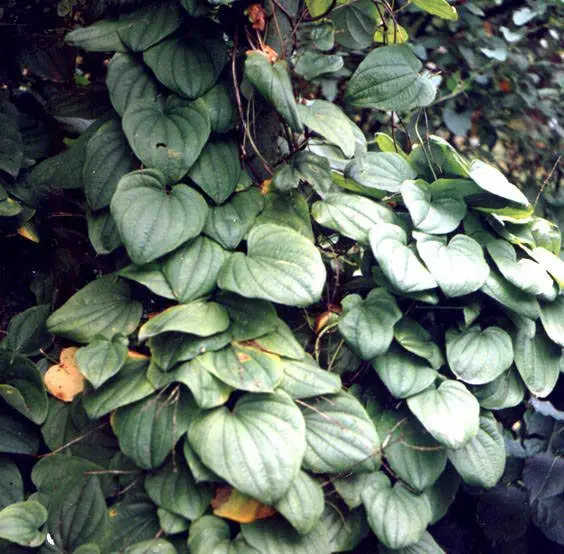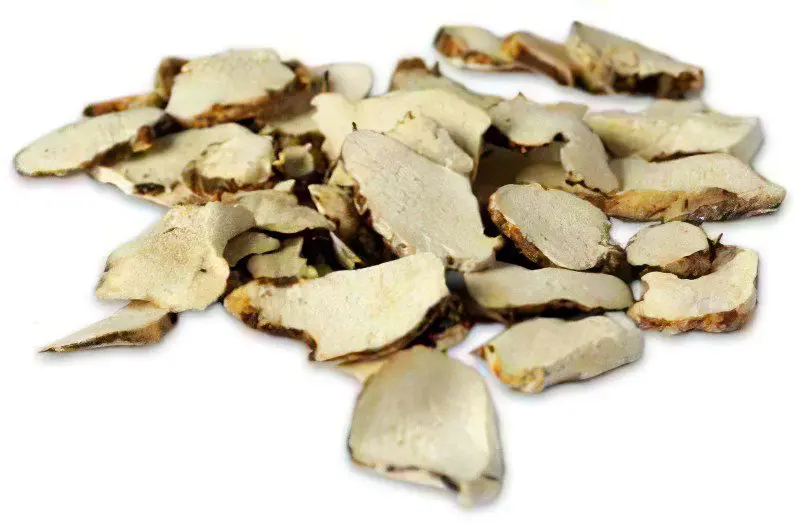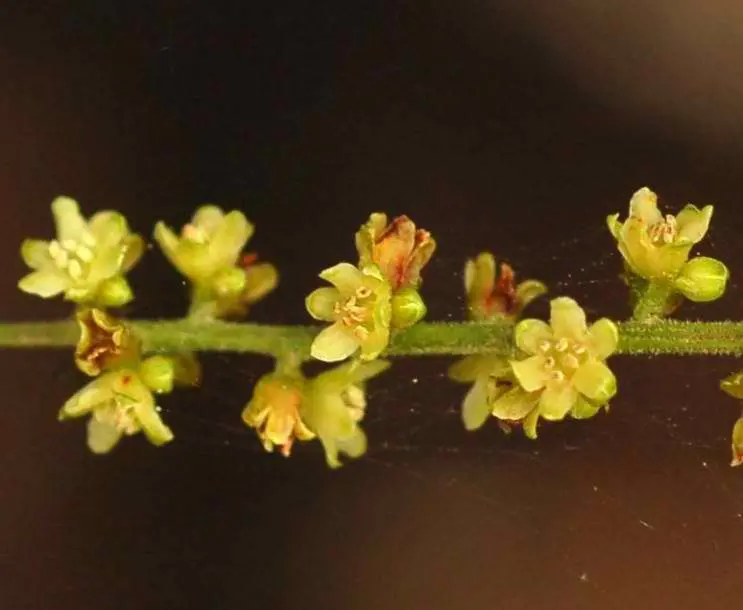Useful properties and application of Caucasian Dioscorea
Botanical characteristics of Caucasian Dioscorea

Dioscorea caucasian – perennial herbaceous vine 2-3 meters long with a thick horizontal rhizome. Leaves 6–15 cm long are heart-shaped or oval, pointed at the ends, densely pubescent below. The flowers are green, small, unisexual, collected in racemes or spikes. The fruits are rounded trihedral capsules. The seeds of the plant are with a pterygoid outgrowth, which gives them good volatility. Dioscorea blooms in May-June, fruits ripen in September.
The plant is endemic, grows only in Abkhazia and the Adler region of the Krasnodar Territory. It is listed in the Red Book, in connection with which measures have been taken to cultivate Dioscorea.
Useful properties of Dioscorea
Dioscorea refers to medicinal plants, used in the treatment of many diseases. The most effective on the human body is the effect of preparations from the rhizome of vines that have reached the age of 25. The collection of roots is carried out in spring and autumn, until the first frost. Well-dried raw materials can be stored for three years. Decoctions and infusions of Dioscorea have an immunomodulatory, tonic, sedative, diuretic, choleretic effect.
The main active ingredients are steroid glucosides, they are able to bind and remove cholesterol. The chemical composition of the plant also includes starch and fat-like substances.
Application of Dioscorea

Dioscorea helps well with disorders of the adrenal glands, the immune system, inflammation of the trigeminal nerve, vegetative-vascular dystonia, rheumatoid arthritis, atherosclerosis of the vessels of the brain and other organs. Preparations from it improve sleep, memory, heart, liver and kidney function. The plant is successfully used to treat headaches, restore vision in cataracts. It relieves fatigue and irritability, removes tinnitus, improves sleep and mood.
Dioscorea lowers blood cholesterol and prevents lipid deposition in the arteries and liver, dilates peripheral vessels and improves coronary blood flow, reduces the frequency of angina attacks and relieves tachycardia. Infusions and extracts from the plant stimulate the motor and secretory activity of the gastrointestinal tract. In diabetic patients, the general condition improves and positive changes in lipid metabolism are outlined, the prothrombin index is normalized.
Preparations of Dioscorea increase the life of irradiated mice, creating a semblance of an X-ray protective effect. The use of such drugs for hypertriglyceridemia is quite effective. Also, positive results have been obtained when using Dioscorea in conjunction with other herbs in the treatment of such severe systemic diseases as lupus erythematosus, multiple sclerosis, glomerulonephritis, scleroderma, sarcoidosis.
Dioscorea root
The rhizomes of Caucasian Dioscorea contain up to 25% steroid glycosides (saponins). The most significant of them are dioscin, protodioscin, protogracillin. The roots are harvested from the end of April until the first frost, carefully digging them out of the ground with a shovel. After that, they are cut into pieces 30 cm long, dried at a temperature of 60-70 ° C. Due to the fact that Dioscorea is listed in the Red Book, plants grown under artificial conditions are used for medical purposes.
The rhizomes of the vines are compact, thick, with tuberous thickenings, yellow at the break.
Dioscorea tincture
Recipe № 1. 100 g of dry crushed roots should be poured with 500 ml of vodka, insisted for at least 10 days in a dark, cool place, shaking occasionally, strain. Dosage – 25-30 drops 3 times a day, approximately 30 minutes after meals.
Recipe № 2. 7,5 tablespoons of dry crushed roots should be poured over 1,5 liters of vodka and infused in a dark place for 10 days. The tincture is drunk with warm tea at the rate of 1 teaspoon 3 times a day after meals. This remedy helps well after strokes and with heart diseases. Treatment consists of three to four courses with a break of 1 month.
Broth recipe: 1 teaspoon of dry crushed root is poured with a glass of boiling water and heated in a steam bath for 20 minutes. After cooling and straining, the decoction can be drunk 1 tablespoon 3 times a day after meals, for 3-4 weeks. For treatment, 3 courses are taken with a break of 7 days. You can repeat the treatment every 4-6 months
Dioscorea tea
The roots of the plant can be brewed into teas. To do this, mix 70% green tea and 30% crushed Dioscorea root. Consume in the morning, 1 hour after meals, 1 time per day. This tea normalizes the level of cholesterol in the blood, improves memory and normalizes sleep. This is a good prevention of hypertension and atherosclerosis. To prevent bloating, you can drink tea brewed from a mixture of herbs such as dioscorea root, ginger, fennel, chamomile, peppermint or lemon balm. Consume it after meals.
Dioscorea with honey
In atherosclerosis, it is useful to take powder from rhizomes, eating it with a spoon of honey, or drinking honey water. Dosage: 0,2 g of powder (fits on the tip of a knife) 3 times a day for 10 days 30 minutes after meals. Treatment is carried out for 3-4 months with weekly breaks between courses.
Honey also has many beneficial properties. It calms the nervous system, is good for the heart, improves sleep and memory, normalizes metabolism, is well absorbed by the kidneys, and does not irritate the gastric mucosa. It contains many vitamins, it contains manganese, calcium, sodium, magnesium, phosphorus, iron, magnesium, etc.
Dioscorea japonica

Dioscorea japonica is also known as wild yam. This species differs from Dioscorea in the Caucasian shape of the leaves, the length of the stem, reaching 4 m in height, thicker rhizomes (up to 5 cm), a broadly elliptical fruit box and a smaller number of male spikelets. The lower leaves are seven-lobed, with a large and elongated middle part, the middle ones have 3-5 lobes, the upper ones are practically without lobes. The flowers are small, unisexual, with a yellowish-green perianth. The plant propagates by seeds and shoots.
Japanese Dioscorea is widespread in the Far East, in its southern part. Listed in the Red Book, cultivated. For medicinal purposes, rhizomes are harvested, starting from April and ending with the first frosts. The active ingredients are steroid glycosides (saponins), which are derivatives of diosgenin. The most important of these is dioscin.
Saponins reduce cholesterol in the blood, so they are recommended both for the prevention of atherosclerosis and for its treatment. As a result of the use of decoctions and infusions, tinnitus, headache, fatigue are reduced or completely disappear. Dioscorea acts as a diuretic, it increases the secretion of bile and reduces blood clotting.
Due to its “antispasmodic” actions, wild yam helps relieve menstrual cramps, dysmenorrhea, and also regulates contractions during childbirth. It also provides pain relief after pelvic surgery associated with endometriosis, removal of fibroids or cysts, cuts, and postpartum pain.
Dioscorea opposite
This ancient cultivated plant is common in Japan and China. Its stems, slightly angular or twisted, reach a length of up to 9 m. The leaves are opposite, 4–7 cm long, broadly heart-shaped at the base and almost three-lobed towards the ends. In the axils of the leaves are spherical nodules. The flowers are whitish, cinnamon-scented and produce single or paired axillary racemes. For medicinal purposes, the roots of the plant and sometimes the leaves are used. Rhizomes are harvested at the end of the growing season – in the fall.
Dioscorea opposite is an excellent medicine for diseases of the kidneys, stomach, and spleen. It is used as an expectorant. A tincture of the leaves is excellent for dry asthmatic coughs. A decoction of the leaves of Dioscorea is used for menopause in women, along with the berries of wolfberry and Chinese licorice, dogwood, and sticky rhemania. Crushed roots can be included in herbal preparations for urination disorders and bronchial asthma.
Dioscorea nipponskaya

It is endemic to East Asia. It is distributed in the Primorsky Territory, in the southeast of the Amur Region, in the south of the Khabarovsk Territory, as well as in China and Japan. Stems glabrous, up to 4 m long, rhizome thick, horizontal. The leaves are alternate, broadly heart-shaped, with three, five or seven lobes. The flowers are yellowish-green on short stalks, collected in racemes, rarely in panicles. For the production of medicines, rhizomes are harvested in September-October. Dried raw materials can be stored for 3 years.
Powders and decoctions from the rhizome have a pronounced diuretic, choleretic and anti-sclerotic effect, reduce blood pressure and blood clotting. From the roots and rhizomes, a dry extract of “Polysponin” is made, which prevents the deposition of lipids in the liver and the cardiovascular system. It removes “bad” cholesterol, improves heart function and increases diuresis. The extract is used for the prevention and treatment of atherosclerosis and hypertension.
The positive effect of Dioscorea in this case is associated with a slower absorption of cholesterol in the intestine and a decrease in its level in the blood. Cholesterol is retained in the state of a colloidal solution and is excreted from the body without having time to be deposited on the walls of blood vessels.
Dioscorea ivory
Dioscorea ivory is native to South Africa, where this exotic plant grows naturally. Its uniqueness lies in the presence of a spherical aerial tuber (caudex), which under ideal conditions can reach a height of 3 m with a diameter of 1 m and a weight of up to 400 kg. From a distance, the caudex resembles a tortoise shell, as it is covered with polygonal cork-like growths. With such dimensions, the root system of the plant is surprisingly small and is located mainly in the surface layer of the earth.
Thin curly shoots sprout from the top of the tuber, the length of which is from two to five meters. The leaves are alternate, broadly heart-shaped, with rounded lobes. Their length is 2-5 cm. Small yellowish-green flowers are collected in racemose inflorescences. The pulp of the caudex is edible. It is similar to the flesh of a turnip and is rich in starch. For many Africans, it is a staple food.
This type of Dioscorea is not used for medicinal purposes, but it is valued as an ornamental plant.
Dioscorea hairy
This perennial herbaceous vine grows in the dense forests of North America (Indiana, North Carolina, Virginia). It has a knotty woody rhizome and thin branching shoots up to 5 m high. The leaves are alternate, pubescent, with 7–11 veins. Petioles glabrous or nearly glabrous. The flowers are small, yellowish-green, collected in drooping inflorescences. Dioscorea blooms in June – early July.
As a medicinal raw material, rhizomes containing saponins are harvested. On the basis of shaggy dioscorea, contraceptives and creams for the treatment of eczema are made. It is an effective anti-inflammatory, antipyretic, antispasmodic, choleretic and antirheumatic agent. Due to its ability to dilate blood vessels, Dioscorea helps with cramps and spasms in the premenstrual period.
The plant contains phytoestrogens, including diosgenin. It is the natural precursor of progesterone. The use of decoctions and infusions of the roots of Dioscorea hairy during menopause prevents the development of osteoporosis, in addition, the work of the sex glands is regulated. Dioscorea preparations also help in the treatment of urinary tract and cystitis.
Contraindications to the use of Dioscorea
Dioscorea is not recommended for patients with bradycardia and pregnant women. No other contraindications have been identified. Saponins can irritate the mucosa of the gastrointestinal tract, so decoctions and tinctures must be taken after meals. When using drugs in rare cases, side effects may occur: loss of appetite, itching, intestinal disorders, sweating. If such symptoms appear, reduce the dose or temporarily stop taking Dioscorea.









